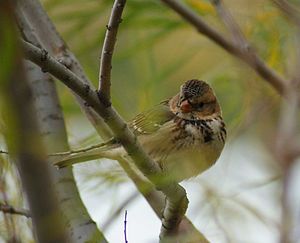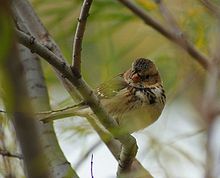Nigravizaĝa emberizo
  Nigravizaĝa emberizo
| ||||||||||||||
| Biologia klasado | ||||||||||||||
| ||||||||||||||
| Zonotrichia querula (Nuttall, 1840) | ||||||||||||||
| Konserva statuso | ||||||||||||||
 | ||||||||||||||
Aliaj Vikimediaj projektoj
| ||||||||||||||


La Nigravizaĝa emberizo, Nigravizaĝa zonotriĥo aŭ Nigravizaĝa plumzonulo, Zonotrichia querula, estas mezgranda birdospecio membro de la grupo de Amerikaj paseroj indiĝena de Nordameriko kaj membro de la genro de zonotriĥoj, kiu enhavas speciojn de brunstriecaj dorsoj kaj distingaj kapobildoj.
Ties reprodukta habitato estas la norda parto de centra Kanado (ĉefe la Nordokcidentaj Teritorioj kaj Nunavuto, kun teritorioj iome al norda Manitobo kaj Saskaĉevano). Fakte tiu birdospecio estas la ununura kanada endemia reproduktanto. Vintre ili migras al la usonaj subŝtatoj de la Nordamerikaj Grandaj Ebenaĵoj, el malsupra Suda Dakoto al supra Teksaso.
La plej rimarkinda karaktero de tiu specio diference de la samgenranoj estas nigra kapozono kiu nomigas ĝin laŭ la komuna nomo kiu konsistas el nigraj krono, ampleksa bridareo, gorĝareo kaj disiĝe al supra brusto kiel horizontala strio plu brustocentra makulo. La resto de la kapo estas helgriza (al sablokolora) kun iomete pli malhelgriza orelareo kun pli markata malantaŭa bordo preskaŭ nigreca. La fortika beko kaj la kruroj estas rozkoloraj. La supra dorso montras nigrecan vertikalan striecon super helbruna al helgriza fono kiu pluas al suba dorso kaj pugo senstriaj; la vosto estas iomete pli malhela. La subaj partoj estas helgrizaj kun nigreca strieco en brustaj flankoj. La okulirisoj estas brunaj.
La komuna nomo de tiu specio en la angla nome Harris's Sparrow rememoras la usonan amatoran ornitologon nome Edward Harris (1799–1863).
Referencoj[redakti | redakti fonton]
- BirdLife International (2004). Zonotrichia querula. Internacia Ruĝa Listo de Endanĝeritaj Specioj, eldono de 2006. IUCN 2006. Elŝutita 12a Majo 2006. Malplej Zorgiga
Eksteraj ligiloj[redakti | redakti fonton]
- Informaro kaj Fotoj de Nigravizaĝa emberizo - Suddakotaj Birdoj kaj Birdumo
- Speciinformaro pri Nigravizaĝa emberizo – Laboratorio Cornell de Ornitologio
- Nigravizaĝa emberizo - Zonotrichia querula - USGS Patuxent Birdidentigejo
- Fotaro de Nigravizaĝa emberizo VIREO
Plia legado[redakti | redakti fonton]
Libro[redakti | redakti fonton]
- Norment, CJ. Ph.D. (2007). Return to Warden's Grove: Science, desire, and the lives of sparrows. Iowa City, IA: University of Iowa Press.
- Norment, C. J. and S. A. Shackleton. 1993. Harris’s Sparrow (Zonotrichia querula). In The Birds of North America, No. 64 (A. Poole and F. Gill, Eds.). Philadelphia: The Academy of Natural Sciences; Washington, D.C.: The American Ornithologists’ Union.
Tezoj[redakti | redakti fonton]
- Norment CJ. Ph.D. (1992). The comparative breeding ecology of the Harris' sparrow (Zonotrichia querula) and white-crowned sparrow (Zonotrichia leucophrys) in the Northwest Territories, Canada. University of Kansas, United States, Kansas.
- Watt DJ. Ph.D. (1983). PLUMAGE COLORATION AND DOMINANCE BEHAVIOR IN THREE SPECIES OF SPARROWS OF THE GENUS ZONOTRICHIA. The University of Oklahoma, United States, Oklahoma.
Artikoloj[redakti | redakti fonton]
- Bridgwater DD. (1968). Winter Movement and Habitat Use by Harris Sparrow Zonotrichia-Querula. Proceedings of the Oklahoma Academy of Science. vol 47, pp. 53–59.
- Cook WM. (2004). Inadvertent bird captures in Sherman small mammal traps in an old field mosaic. Transactions of the Kansas Academy of Science. vol 107, no 3-4. pp. 170–172.
- Degraw WA & Kern MD. (1985). Changes in the Blood and Plasma Volume of Harris Sparrows Zonotrichia-Querula During Postnuptial Molt. Comparative Biochemistry & Physiology A. vol 81, no 4. pp. 889–894.
- Degraw WA & Kern MD. (1990). Postnuptial Molt in Harris' Sparrows. Condor. vol 92, no 4. pp. 829–838.
- Jackson WM, Rohwer S & Winnegrad RL. (1988). Status Signaling Is Absent within Age-and-Sex Classes of Harris' Sparrows. Auk. vol 105, no 3. pp. 424–427.
- Keating JF, Robel RJ, Adams AW, Behnke KC & Kemp KE. (1992). Role of handling time in selection of extruded food morsels by two granivorous bird species. Auk. vol 109, no 4. pp. 863–868.
- Norment CJ. (1992). Comparative breeding biology of Harris' sparrows and gambel's white-crowned sparrows in the Northwest Territories, Canada. Condor. vol 94, no 4. pp. 955–975.
- Norment CJ. (1993). Nest-site characteristics and nest predation in Harris' sparrows and white-crowned sparrows in the Northwest Territories, Canada. Auk. vol 110, no 4. pp. 769–777.
- Norment CJ. (1994). Breeding site fidelity in Harris' Sparrows, Zonotrichia querula, in the Northwest Territories. Canadian Field Naturalist. vol 108, no 2. pp. 234–236.
- Norment CJ. (1995). Incubation patterns in Harris' Sparrows and White-Crowned Sparrows in the Northwest Territories, Canada. Journal of Field Ornithology. vol 66, no 4. pp. 553–563.
- Norment CJ. (1995). Prebasic (postnuptial) molt in free-ranging Harris' Sparrows, Zonotrichia querula, in the Northwest Territories, Canada. Canadian Field-Naturalist. vol 109, no 4. pp. 470–472.
- Norment CJ. (2003). Patterns of nestling feeding in Harris's Sparrows, Zonotrichia querula and White-crowned Sparrows, Z. leucophrys, in the Northwest Territories, Canada. Canadian Field-Naturalist. vol 117, no 2. pp. 203–208.
- Norment CJ & Fuller ME. (1997). Breeding-season frugivory by Harris' sparrows (Zonotrichia querula) and white-crowned sparrows (Zonotrichia leucophrys) in a low-Arctic ecosystem. Canadian Journal of Zoology-Revue Canadienne De Zoologie. vol 75, no 5. pp. 670–679.
- Peck GK & James RD. (1998). Breeding birds of Ontario: Nidology and distribution: Volume 2: Passerines (first revision - Part C: Tanagers to Old World sparrows). Ontario Birds. vol 16, no 3. pp. 111–127.
- Randall RN. (2004). Christmas bird counts for North Dakota 2003. Prairie Naturalist. vol 36, no 2. pp. 119–124.
- Robel RJ, Barnes ME, Kemp KE & Zimmerman JL. (1990). Influences of Time Postmortem Feeding Activity and Diet on Digestive Organ Morphology of Two Emberizids. Auk. vol 107, no 4. pp. 669–677.
- Robel RJ, Keating JF, Zimmerman JL, Behnke KC & Kemp KE. (1997). Consumption of colored and flavored food morsels by Harris' and American tree sparrows. Wilson Bulletin. vol 109, no 2. pp. 218–225.
- Rohwer S. (1977). Status Signaling in Harris Sparrows Some Experiments in Deception. Behaviour. vol 61, no 1-2. pp. 107–129.
- Rohwer S. (1985). Dyed Birds Achieve Higher Social Status Than Controls in Harris' Sparrows Zonotrichia-Querula. Animal Behaviour. vol 33, no 4. pp. 1325–1331.
- Rohwer S & Ewald PW. (1981). The Cost of Dominance and Advantage of Subordination in a Badge Signaling System. Evolution. vol 35, no 3. pp. 441–454.
- Rohwer S, Ewald PW & Rohwer FC. (1981). Variation in Size Appearance and Dominance within and among the Sex and Age Classes of Harris Sparrows Zonotrichia-Querula. Journal of Field Ornithology. vol 52, no 4. pp. 291–303.
- Rohwer S & Rohwer FC. (1978). Status Signaling in Harris Sparrows Experimental Deceptions Achieved. Animal Behaviour. vol 26, no 4. pp. 1012–1022.
- Rohwer S & Wingfield JC. (1981). A Field Study of Social Dominance Plasma Levels of Luteinizing Hormone and Steroid Hormones in Wintering Harris Sparrows Zonotrichia-Querula. Zeitschrift fuer Tierpsychologie. vol 57, no 2. pp. 173–183.
- Sexton JW & Harker DFJ. (1972). Harriss Sparrow in Montgomery County Tennessee. Migrant. vol 43, no 1. pp. 20–21.
- Shackleton SA, Ratcliffe L, Horn AG & Naugler CT. (1991). SONG REPERTOIRES OF HARRIS SPARROWS (ZONOTRICHIA-QUERULA). Canadian Journal of Zoology-Revue Canadienne De Zoologie. vol 69, no 7. pp. 1867–1874.
- Shuman TW, Robel RJ, Zimmerman JL & Kemp KE. (1992). Time Budgets of Confined Northern Cardinals and Harris' Sparrows in Flocks of Different Size and Composition. Journal of Field Ornithology. vol 63, no 2. pp. 129–137.
- Spicer GS. (1977). 2 New Nasal Mites of the Genus Ptilonyssus Mesostigmata Rhinonyssidae from Texas USA. Acarologia. vol 18, no 4. pp. 594–601.
- Wassenaar LI & Hobson KA. (2001). A stable-isotope approach to delineate geographical catchment areas of avian migration monitoring stations in North America. Environmental Science & Technology. vol 35, no 9. pp. 1845–1850.
- Watt DJ. (1986). A Comparative Study of Status Signaling in Sparrows Genus Zonotrichia. Animal Behaviour. vol 34, no 1. pp. 1–15.
- Watt DJ. (1986). Relationship of Plumage Variability Size and Sex to Social Dominance in Harris' Sparrows Zonotrichia-Querula. Animal Behaviour. vol 34, no 1. pp. 16–27.
- Wilson FE. (1990). On the Recovery of Photosensitivity in Two Passerine Species American Tree Sparrows Spizella-Arborea and Harris' Sparrows Zonotrichia-Querula. General & Comparative Endocrinology. vol 79, no 2. pp. 283–290.
- Wilson FE. (1991). THE RECOVERY OF PHOTOSENSITIVITY IN MALE HARRIS SPARROWS (ZONOTRICHIA-QUERULA). American Zoologist. vol 31, no 5. p. A21-A21.
- Wilson FE. (1992). PHOTOREFRACTORY HARRIS SPARROWS (ZONOTRICHIA-QUERULA) EXPOSED TO A WINTER-LIKE DAYLENGTH GRADUALLY REGAIN PHOTOSENSITIVITY AFTER A LAG. General and Comparative Endocrinology. vol 87, no 3. pp. 402–409.
| ||||||||||||||||||




